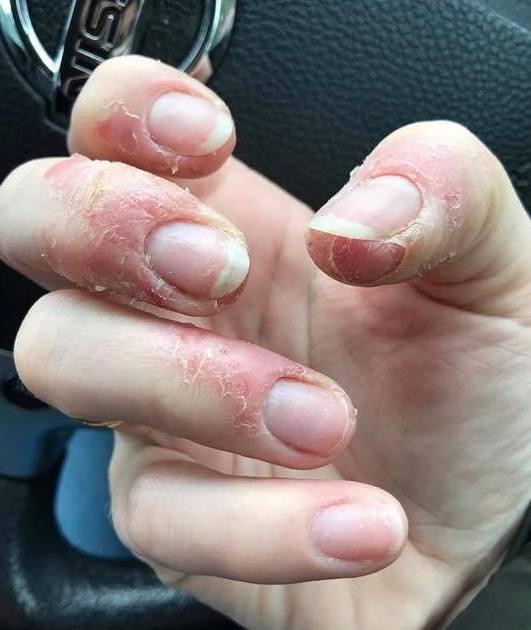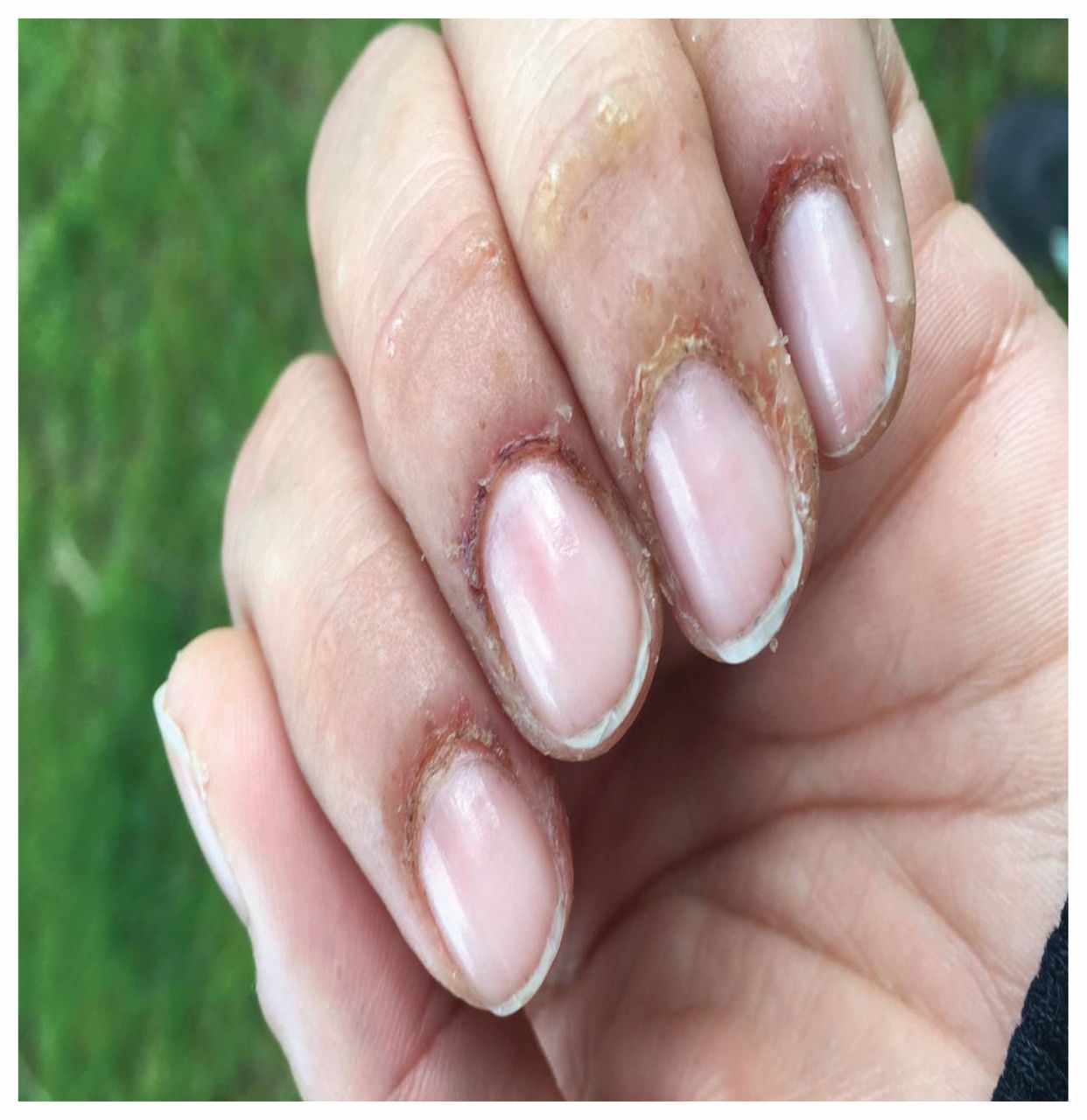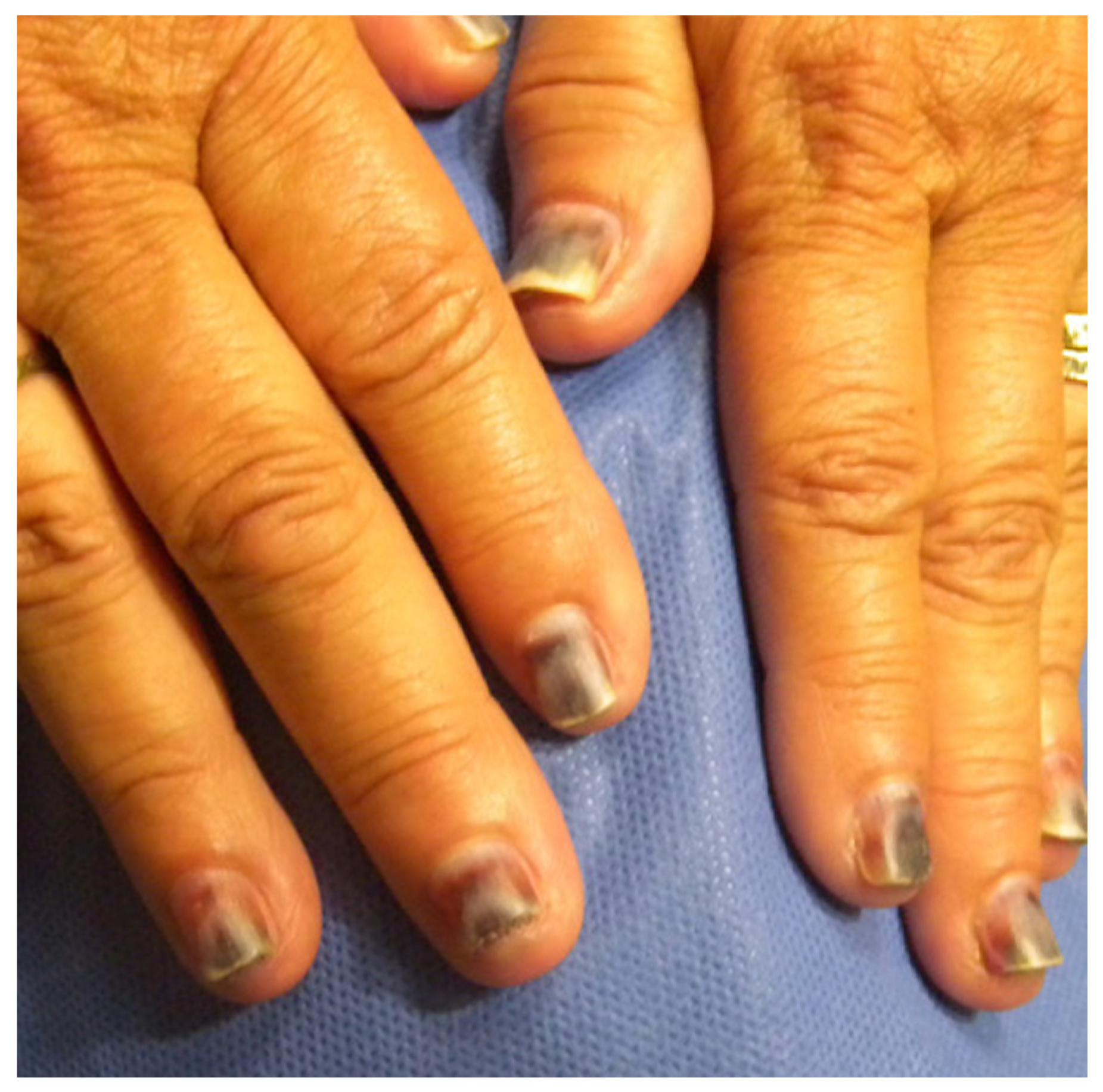Acrylic Nails & Contact Dermatitis: What You Need To Know
Could the quest for the perfect manicure be masking a hidden health risk? Allergic contact dermatitis, a common but often overlooked reaction, is increasingly linked to the very products designed to beautify our nails, particularly those found in acrylic and gel treatments.
The allure of long-lasting, flawlessly polished nails has fueled the popularity of acrylic and gel manicures. However, beneath the glossy surface lies a potential threat: the development of allergic contact dermatitis (ACD). This condition, a form of eczema, arises when the skin comes into contact with allergens present in nail cosmetic products. Symptoms can range from mild irritation to severe inflammation, affecting both consumers and nail professionals. The chemicals responsible, often acrylates and methacrylates, are recognized as common culprits, capable of sensitizing the immune system and triggering a cascade of reactions. A clear temporal relationship between nail cosmetic procedures and an eczematous outbreak on the hands, face, or other ectopic body regions can be a key indicator of CD.
| Condition: | Allergic Contact Dermatitis (ACD) |
| Affected: | Consumers, Nail Technicians (Nail Stylists) |
| Primary Cause: | Exposure to allergens, primarily acrylates and methacrylates, found in nail cosmetics (acrylics, gels, polishes). |
| Common Symptoms: | Redness, Itching, Swelling, Dryness, Peeling skin, Burning, Pain, Inflammation. May appear on fingertips, nail bed, around the eyes, or other areas. |
| Triggers: | Acrylic nails, gel nails, nail polish, fragrances, creams, and other nail cosmetic products containing sensitizing chemicals. |
| Related Conditions: | Nail Eczema, Nail Psoriasis (precursors may be eczema or psoriasis elsewhere on the body), Onychodystrophy, psoriasiform. |
| Onset: | Symptoms can appear rapidly ("This one hit hard and fast") or develop gradually over time. |
| Professional Impact: | Occupational ACD is a concern for nail technicians due to repeated exposure. |
| Treatment: | Avoiding the allergen, topical corticosteroids, emollients. Consultation with a dermatologist is recommended. |
| Reference: | PubMed Central (U.S. National Library of Medicine) |
The connection between acrylic nails and contact dermatitis lies in the allergens present in nail cosmetics. These chemicals, used to create the hard, durable surfaces we crave, can trigger an allergic reaction when they come into contact with the skin. It's not just the nails themselves; the products used in the process, including primers, bonding agents, and topcoats, can also harbor these problematic substances. The application and removal processes, often involving filing, buffing, and the use of harsh solvents, can further compromise the skin's natural barrier, increasing the likelihood of an adverse reaction. These include but are not limited to tosylamide, (meth)acrylates, and formaldehyde.
- 4h Fair Mullica Hill What You Need To Know In July 2024
- Christa Miller Roles Career More All You Need To Know
The symptoms of ACD can manifest in various ways. It often begins with itchiness in the nail bed, which may then become dry. Redness, swelling, and blistering can also occur, extending to the fingertips and surrounding skin. In severe cases, the nail plate itself can be affected, leading to onycholysis (lifting of the nail from the nail bed), pitting, and discoloration. The skin under the nail begins to peel and fingertips/pads may become itchy. Even the eyes can be affected, with rashes appearing around the eyelids, as one woman discovered after using gel polish at home and developing "horrible congestion," eventually leading to contact dermatitis around her eye.
The increasing prevalence of ACD related to nail cosmetics is a growing concern. "Hundreds of scientific articles have documented the rising prevalence of allergic reactions to acrylates in salon workers and clients," highlighting the widespread nature of the problem. The risk isn't limited to the immediate aftermath of a manicure; some individuals may develop sensitization over time, meaning they can develop an allergy to gel, which means the wearer would never be able to use gel again. This allergy is an example of contact dermatitis. In some cases, even exposure to the fumes from these products can trigger a reaction, even when wearing a mask, as one individual reported after starting to do gel nails at home. The rising trend in allergic contact dermatitis to acrylic nail products.
The chemicals responsible for these reactions are often acrylates, specifically (meth)acrylates. These compounds, used to create the hard, durable finish of acrylic and gel nails, are potent sensitizers. They're found in various products, including primers, bonding agents, and topcoats. As the skin comes into contact with these allergens, it triggers an allergic reaction, leading to the characteristic symptoms of ACD. The risk of an allergic reaction exists if you arent careful.
- Nzinga Imani From Acting To Entrepreneurship More
- Breaking David Lebryk Leaves Treasury Amid Musk Clash
Professional nail technicians are particularly vulnerable to ACD due to their frequent exposure to these chemicals. 9, 10 both consumers and professional nail technicians (nail stylists) may be affected, causing occupational acd.Repeated contact with these substances, coupled with the physical stress of the job, can compromise the skin's protective barrier, increasing the risk of sensitization. In 2014, contact allergy to artificial nails was still infrequent , yet there were several cases of occupational contact dermatitis from acrylic nails in beauticians [10,11,12] and one case in a flamenco guitar player being reported. Occupational contact dermatitis often manifests on the hands, but can also affect the face and other exposed areas.
The diagnosis of ACD typically involves a thorough examination of the affected areas, medical history, and potentially patch testing. Patch testing involves applying small amounts of suspected allergens to the skin under controlled conditions to identify specific triggers. A clear temporal relationship between nail cosmetic procedures and an eczematous outbreak on the hands, face, or other ectopic body regions can be a key indicator of CD. The treatment for ACD focuses on avoiding the offending allergen and managing the symptoms. This may involve the use of topical corticosteroids to reduce inflammation, emollients to soothe the skin, and, in severe cases, systemic medications. Alternatives for the 2007 north american contact dermatitis group (nacdg) standard screening tray. We report 2 cases of acd to acrylic nails with severe onychodystrophy and psoriasiform
The use of gel nail polish (GNP) has surged in popularity, but this trend is shadowed by an increase in complications. Allergic reactions can manifest in two primary ways, as reported by Stern: Type IV hypersensitivity (delayed reaction) and Type I hypersensitivity (immediate reaction). The latter is characterized by rapid onset, with burning, pain, and inflammation beginning instantly upon contact. The burning, pain, and inflammation of the skin begin instantly. I've been using beetles gel polish for about a year and a couple months ago i started developing contact dermatitis under my nails.
In addition to ACD, other nail conditions can be mistaken for, or coexist with, reactions to nail products. Nail eczema and nail psoriasis, for example, share some similarities. Both can cause pitting in the nails. Nail psoriasis also causes lifting and white discoloration in the nails. While nail eczema can appear at any age, nail psoriasis typically shows up in older adults. Amber from @amberthenailwhisperer warned that, over time, this could cause an allergy to gel meaning the wearer would never be able to use gel again.
While acrylic nails arent inherently bad for your nails, but they can be harmful to your skin. It's crucial to be informed about the potential risks and take precautions to minimize exposure. If you suspect you have ACD, consult with a dermatologist for accurate diagnosis and guidance. Im too scared to return to a salon to have my nails done professionally, even though they were never the cause of the reaction!!
The use of nail cosmetics can lead to contact dermatitis, caused by chemicals in polishes, fragrances, or creams. In 2014, contact allergy to artificial nails was still infrequent , yet there were several cases of occupational contact dermatitis from acrylic nails in beauticians [10,11,12] and one case in a flamenco guitar player being reported. Allergic contact dermatitis caused by nail acrylates in europe.
- Unveiling Katee Owen Bio Career More News Updates
- Trump Rally Shooting Debunking False Claims Identifying The Shooter Latest News

Dermatitis NailKnowledge

Contact dermatitis caused by methacrylates in nail products CMAJ

Allergies Free Full Text Contact Dermatitis in Nail Cosmetics